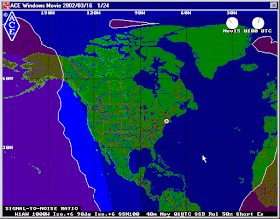Product: Weekly Highlights and Forecasts
:Issued: 2016 Jan 18 0131 UTC
# Prepared by the US Dept. of Commerce, NOAA, Space Weather Prediction Center
# Product description and SWPC web contact www.swpc.noaa.gov/weekly.html#
# Weekly Highlights and Forecasts
#
Highlights of Solar and Geomagnetic Activity 11 - 17 January 2016
Solar activity ranged from very low to low levels. Very low conditions were observed on 11-14 January and again on 16-17 January. Low levels occurred on 15 January with a few weak C-class flares observed from Region 2480 (N02, L=125, class/area Eso/190 on 10 Jan). A 14 degree long filament, centered near S30W03, erupted between 14/1803-2048 UTC. An associated coronal mass ejection (CME) was visible in SOHO LASCO imagery beginning at 14/2324 UTC. Analysis, and subsequent WSA-Enlil model output, determined a potential glancing blow could impact Earth early on 19 Jan. No proton events were observed at geosynchronous orbit.
The greater than 2 MeV electron flux at geosynchronous orbit was at high levels throughout the summary period.
Geomagnetic field activity began the period on 11-14 January at quiet to active levels due to effects from a negative polarity coronal hole high speed stream (CH HSS). Quiet conditions persisted on 15-17 January. ACE satellite parameters indicated a maximum wind speed reading of 662 km/s at 12/0711 UTC. By period's end, wind speeds had declined to about 330 km/s. Total field (Bt) reached a maximum reading of 10 nT late on the 10th and generally ranged between 3-7 nT for a majority of the period. The Bz component varied between +/- 7 nT from late on the 11th through early on the 13th. Through the remainder of the period, Bz did not vary much beyond +/- 4 nT. The phi angle was in a predominately negative (towards) orientation through midday on 16 January when a rotation to a more positive (away) sector was observed.
Forecast of Solar and Geomagnetic Activity 18 January - 13 February 2016
Solar activity is expected to be at very low levels with a chance for C-class flares throughout the outlook period.
No proton events are expected at geosynchronous orbit.
The greater than 2 MeV electron flux at geosynchronous orbit is expected to be at high levels on 18, 23-26, 29-31 January, 01-06 and 09-13 February. Normal to moderate levels are expected for the
remainder of the outlook period.
Geomagnetic field activity is expected to be at unsettled to active periods on 18-19 January due to possible glancing blow effects from the 14 Jan CME. Unsettled to active levels are expected on 22-23, 28-29 January, 02-03 and 07-09 February due to recurrent CH HSS effects. Predominately quiet levels are expected for the remainder of the outlook period.
Product: 27-day Space Weather Outlook Table 27DO.txt
:Issued: 2016 Jan 18 0131 UTC
# Prepared by the US Dept. of Commerce, NOAA, Space Weather Prediction Center
# Product description and SWPC web contact www.swpc.noaa.gov/wwire.html#
# 27-day Space Weather Outlook Table
# Issued 2016-01-18
#
# UTC Radio Flux Planetary Largest
# Date 10.7 cm A Index Kp Index
2016 Jan 18 100 8 3
2016 Jan 19 95 15 4
2016 Jan 20 95 10 3
2016 Jan 21 95 8 3
2016 Jan 22 95 12 4
2016 Jan 23 100 8 3
2016 Jan 24 100 5 2
2016 Jan 25 100 5 2
2016 Jan 26 105 5 2
2016 Jan 27 105 5 2
2016 Jan 28 105 18 5
2016 Jan 29 105 12 4
2016 Jan 30 100 8 3
2016 Jan 31 105 5 2
2016 Feb 01 110 5 2
2016 Feb 02 110 15 4
2016 Feb 03 110 12 4
2016 Feb 04 110 8 3
2016 Feb 05 105 5 2
2016 Feb 06 105 5 2
2016 Feb 07 105 12 4
2016 Feb 08 105 12 4
2016 Feb 09 105 10 3
2016 Feb 10 105 8 3
2016 Feb 11 105 5 2
2016 Feb 12 100 5 2
2016 Feb 13 100 5 2
(NOAA)
of the outlook period.
